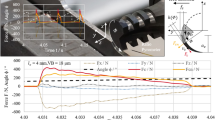Abstract
A new blanking process that involves punch speed up to 10 ms −1 has obvious advantages in increased productivity. However, the inherent dynamics of such a process makes it difficult to develop a practical high speed punch press. The fracture phenomenon governing the blanking process has to be well understood to correctly design the machine support and the tooling. To observe this phenomenon at various controlled blanking speeds a specific experimental device has been developed. The goal is to measure accurately the shear blanking forces imposed on the specimen during blanking. In this paper a new method allowing the blanking forces to be measured and taking into account the proposed test configuration is explained. This technique has been used to determine the blanking forces experienced when forming C40 steel and quantifies the effect of process parameters such as punch die clearance, punch speed, and sheet metal thickness on the blanking force evolution.












Similar content being viewed by others
References
Lascoe OD (1988) Handbook of fabrication processes. ASM International
Nee JG (1998) Fundamentals of tool design, 4th edn. Soc Manuf Eng
Smith DA (1990) Die design handbook, 3rd edn. Soc Manuf Eng
Zener C, Hollomon JH (1944) Effect of strain rate upon plastic flow of steel. J Appl Phys 15(1):22–32
Johnson W, Slater RAC (1964) A comparison of the energy required for slow speed and dynamic blanking using an improved linear motor. Proc Inst Mech Eng 179(1):257
Johnson W, Slater RAC (1965) Further experiments in quasi-static and dynamic blanking of circular discs from various metals. Proc Inst Mech Eng 180:163
Johnson W, Travis FW (1965) High-speed blanking of copper. Proc Inst Mech Eng 180:197–204
Slater RAC, Johnson W (1967) The effects of temperature, speed and strain-rate on the force and energy required in blanking. Int J Mech Sci 9(5):271–276
Stock TAC, Wingrove AL (1971) The energy required for high-speed shearing of steel. J Mech Eng Sci 13(2):110–115
Rogers HC (1979) Adiabatic plastic deformation. Annu Rev Mater Sci 9:283–311
Dowling AR, Harding J, Campbell JD (1970) Dynamic punching of metals. J Inst Met 98:215–224
Zurek AK (1994) The study of adiabatic shear band instability in a pearlitic 4340 steel using a dynamic punch test. Metall Mater Trans A 25(11):2483–2489
Roessig KM, Mason JJ (1999) Adiabatic shear localization in the dynamic punch test, part i: Experimental investigation. Int J Plast 15(3):241–262
Kolsky H (1964) Stress waves in solids. J Sound Vib 1:88–110
Zhao H, Gary G (1995) A three dimensional analytical solution of longitudinal wave propagation in an infinite linear viscoelastic cylindrical bar. Application to experimental techniques. J Mech Phys Solids 43(8):1335–1348
Acknowledgment
This study was carried out with the financial support of CETIM.
Author information
Authors and Affiliations
Corresponding author
Rights and permissions
About this article
Cite this article
Gaudillière, C., Ranc, N., Larue, A. et al. High Speed Blanking: An Experimental Method to Measure Induced Cutting Forces. Exp Mech 53, 1117–1126 (2013). https://doi.org/10.1007/s11340-013-9738-1
Received:
Accepted:
Published:
Issue Date:
DOI: https://doi.org/10.1007/s11340-013-9738-1




